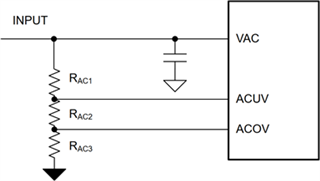Other Parts Discussed in Thread: BQ25750, BQ25820
Tool/software:
The ACUV and ACOV pins program the input voltage operating window for the BQ2575X and the BQ2585X family of parts. When the input voltage is outside the programmed window, the device automatically stops the charger, and the PG pin pulls HIGH. Three resistors control the voltage on the ACUV and ACOV pins to set the operating window. The below image shows the simplified schematic of the connections. RAC1 is normally 1,000kΩ to minimize the input voltage leakage from the voltage divider.

There’s a couple ways to work with the ACUV and ACOV pins to modify the VAC operating window. You can pull the ACUV to VAC and pull ACOV to GND to get the default device operating window. Second, you can use the below equations to calculate the ACOV and ACOV operating window and you can also use the BQ25756 design calculator to help with calculating the resistors.
VVACOVP= 1.2(RAC1+RAC2+RAC3) / RAC3
VVACUVP= 1.1(RAC1+RAC2+RAC3) / (RAC3+RAC3)
The ACUV pin also controls the input voltage dynamic power management (DPM) regulation. This is also called VAC_DPM.
VACUV_DPM= 1.21(RAC1+RAC2+RAC3) / (RAC3+RAC3)
VACUV_DPM will reduce the charge current to keep the input voltage from falling past VACUV_DPM. VACUV_DPM also helps to reduce the input current before the VVACUVP threshold is reached.
Are there special considerations for the BQ25750 or BQ25820 parts?
Yes, there are special considerations for the BQ25750. We recommend that the ΔV between VSYS and VBAT should be as low as possible to minimize the inrush current during the power path switchover. For more information on the power path switchover, you can check this FAQ.

